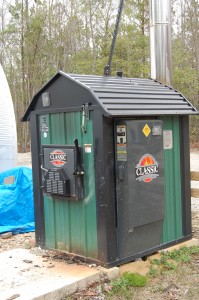 Why would you want to install radiant floor heating in a house anyway? With allergies at an all time high, many people have become keenly aware of how a forced air heating system (i.e. a heat pump, etc.) moves lots of air in order to move the heat around your house. A forced air system is great for quickly raising the temperature of your house. With an adjustment to the thermostat you can raise the temperature in your house in a matter of minutes. The down side to this type of heat is the dust, pollen, dander and pollutants that are made airborne that can cause problems for someone with allergies or asthma.
Why would you want to install radiant floor heating in a house anyway? With allergies at an all time high, many people have become keenly aware of how a forced air heating system (i.e. a heat pump, etc.) moves lots of air in order to move the heat around your house. A forced air system is great for quickly raising the temperature of your house. With an adjustment to the thermostat you can raise the temperature in your house in a matter of minutes. The down side to this type of heat is the dust, pollen, dander and pollutants that are made airborne that can cause problems for someone with allergies or asthma.
A radiant floor system is a coil of flexible tubing that is run throughout the flooring of the house which when in use, heats the floor slowly which then slowly releases the heat into the living space. Much like a passive solar design a radiant floor system work best if it has a large mass to heat. That is why most radiant systems are installed over concrete slabs and then covered themselves with a thin layer on concrete to conceal them. The tubing can be coiled under a wood framed floor system but with not nearly the amount of efficiency that the slab installation will give you because of the lack of mass to store the heat.
So how do you heat the large quantities of water necessary for heating an entire house? The right answer for you depends a lot on your lifestyle. A large gas fired boiler will do the job nicely and with some diligence, you can find ones that operate extremely efficiently. The problem is that the location where you are building has to have access to natural gas in order to make this feasible from a cost standpoint. Propane would be an alternative however propane can be rather costly at times. Not to mention that the trend for gas prices over the past five years is definitely up. An electric boiler would draw a tremendous amount of power and would not be anywhere near as efficient. Look for systems that achieve a 90% efficiency to insure that you are using as little gas as possible.
I have been looking into solar hot water systems for heating water for just this purpose. While it is the energy from the sun is the warming source you still need a small amount of electricity for running the water pumps with most systems. Moving water is much more efficient than moving air and the electricity requirements are minimal. A solar system requires a large warm water storage tank either underground or in the basement of the house. This is a great free source of energy but needs to be backed up with something like a gas boiler for periods where you have many cloudy days in a row.
I like the whole house boiler system for the secondary source of heat. They are a standalone unit that is about the size of a porta potty and sit out in your yard keeping the dirt, smoke and best of all, fire hazard outside your house. The units can burn wood, pellets, corn cobs and several other options. Yes, you do need to feed the fire, but not nearly as often as you think. I went and saw one in use. The guy was heating his house and his shop and supplying all his hot water. He decided not to feed it for a while to see how long it could go before the temperature dropped out of his optimum range. After 3 days of waiting he gave up figuring that he had proved that the unit was extremely efficient.
So if you are thinking that warm floors first thing in the morning on a cold day would be just the thing for you, radiant floors just might be for you.
